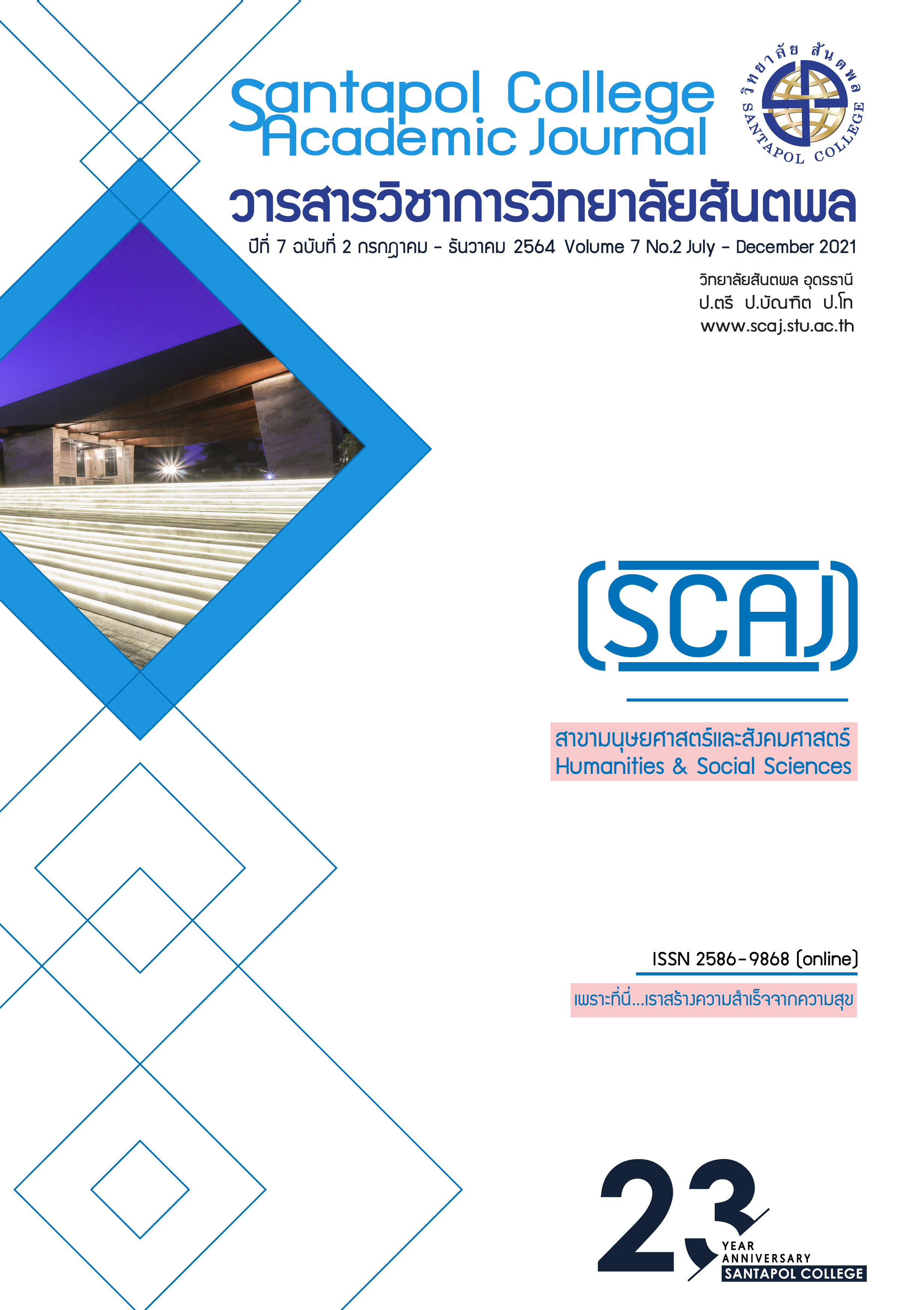โมเดลความสัมพันธ์เชิงสาเหตุความตั้งใจใช้การเรียนรู้ผ่านสื่ออิเล็กทรอนิกส์ของนักศึกษาในช่วง การระบาดของโรคโควิด 19 : การวิเคราะห์โมเดลสมการโครงสร้าง
Main Article Content
บทคัดย่อ
การวิจัยนี้มีวัตถุประสงค์เพื่อศึกษารูปแบบความสัมพันธ์เชิงสาเหตุความตั้งใจใช้การเรียนรู้ผ่านสื่ออิเล็กทรอนิกส์ของนักศึกษาคณะวิทยาการจัดการ มหาวิทยาลัยราชภัฏบ้านสมเด็จเจ้าพระยา กลุ่มตัวอย่างคือนักศึกษาคณะวิทยาการจัดการ มหาวิทยาลัยราชภัฏบ้านสมเด็จเจ้าพระยาจำนวน 400 คน สุ่มตัวอย่างแบบ 2 ขั้นตอนจากชุดข้อมูลทุติยภูมิจากผลการประเมินประสิทธิผลการ
จัดการเรียนรู้ออนไลน์ เครื่องมือที่ใช้ในการวิจัยประกอบด้วย แบบสอบถามข้อมูลส่วนบุคคล แบบวัดการยอมรับการเรียนรู้ผ่าน
สื่ออิเล็กทรอนิกส์โดยและแบบวัดการรับรู้สมรรถนะทางคอมพิวเตอร์ โดยมีค่าความเที่ยงระหว่าง 0.91 - 0.93 วิเคราะห์ข้อมูลด้วย
การหาความถี่ ร้อยละ ค่าเฉลี่ย ส่วนเบี่ยงเบนมาตรฐาน ค่าสัมประสิทธิ์สหสัมพันธ์เปียร์สันและการวิเคราะห์สมการโครงสร้าง
ด้วยโปรแกรมลิสเรล
ผลการวิจัยพบว่ารูปแบบความสัมพันธ์เชิงสาเหตุความตั้งใจเรียนรู้ผ่านสื่ออิเล็กทรอนิกส์ของนักศึกษาคณะวิทยาการจัดการ มหาวิทยาลัยราชภัฏบ้านสมเด็จเจ้าพระยามีความสอดคล้องกับข้อมูลประจักษ์เป็นอย่างดี (2 = 291, df = 109, CFI = 0.99,
RMSEA = 0.04, SRMR = 0.03, CN = 301) สมรรถนะทางคอมพิวเตอร์ การรับรู้ความง่ายในการใช้งานและการรับรู้ประโยชน์เป็นปัจจัยสำคัญที่ให้นักศึกษามีความตั้งใจใช้การเรียนรู้ผ่านสื่ออิเล็กทรอนิกส์
Article Details

อนุญาตภายใต้เงื่อนไข Creative Commons Attribution-NonCommercial-NoDerivatives 4.0 International License.
เนื้อหาและข้อมูลในบทความที่ลงตีพิมพ์ในวารสารวิชาการวิทยาลัยสันตพล ถือว่าเป็นข้อคิดเห็นและความรับผิดชอบของผู้เขียนบทความโดยตรง ซึ่งกองบรรณาธิการวารสารไม่จำเป็นต้องเห็นด้วยหรือรับผิดชอบใดๆ
เอกสารอ้างอิง
Aguilera-Hermida, A. P. (2020). College students’ use and acceptance of emergency online learning due to Covid-19. International Journal of Educational Research Open, 1, 100011.
Al-Azawei, A., Parslow, P., & Lundqvist, K. (2017). Investigating the effect of learning styles in a blended e-learning system: An extension of the technology acceptance model (TAM). Australasian Journal of Educational Technology, 33(2), 1-23.
Al-Okaily, M., Alqudah, H., Matar, A., Lutfi, A. A., & Taamneh, A. (2020). Impact of Covid-19 pandemic on acceptance of elearning system in Jordan: A case of transforming the traditional education systems. Humanities and social Sciences Review, 6(4), 840-851.
Boomsma, A., & Hoogland, J. J. (2001). The robustness of LISREL modeling revisited. Structural equation models: Present & future. A Festschrift in honor of Karl Jöreskog, 2(3), 139-168.
Davis, F. D., Bagozzi, R. P., & Warshaw, P. R. (1989). User acceptance of computer technology: A comparison of two theoretical models. Management science, 35(8), 982-1003.
Davis, F.D. (1989). Perceived usefulness, perceived ease of use, and user acceptance of information technology. MIS quarterly, 13(3), 319-340.
Hair, J. F., Black, W. C., Babin, B.J., & Anderson, R. E. (2010). Multivariate Data Analysis. (7th ed.). London. Pearson Education.
Jeon, J. (2015). The strengths and limitations of the statistical modeling of complex social phenomenon: Focusing on SEM, path analysis, or multiple regression models. International Journal of Social, Behavioral, Educational, Economic, Business and Industrial Engineering, 9(5), 1594-1602.
Kedcham, A., & Sattabut, T. (2020). A development of the self-efficacy scale for teacher colleage students at Bansomdejchopraya Rajabhat University: test of gender invariance. Santapol College Academic Journal, 6(1), 134-144. (In Thai)
Marangunić, N., & Granić, A. (2015). Technology acceptance model: a literature review from 1986 to 2013. Universal access in the information society, 14(1), 81-95.
Preacher, K. J., & Coffman, D. L. (2006). Computing power and minimum sample size for RMSEA [Computer software]. Available online: http://quantpsy.org
Schreiber, J. B. (2017). Update to core reporting practices in structural equation modeling. Research in Social and Administrative Pharmacy, 13(3), 634-643.
Sukendro, S., Habibi, A., Khaeruddin, K., Indrayana, B., Syahruddin, S., Makadada, F. A., & Hakim, H. (2020). Using an extended Technology Acceptance Model to understand students’ use of e-learning during Covid-19: Indonesian sport science education context. Heliyon, 6(11), e05410.
Tarhini, A., Hone, K., & Liu, X. (2014). Measuring the moderating effect of gender and age on e-learning acceptance in England: A structural equation modeling approach for an extended technology acceptance model. Journal of Educational Computing Research, 51(2), 163-184.
UNESCO, (2020). COVID-19 Impact on Education. Retrieved March 29, 2020 from https://en.unesco.org/covid19/educationresponse.


